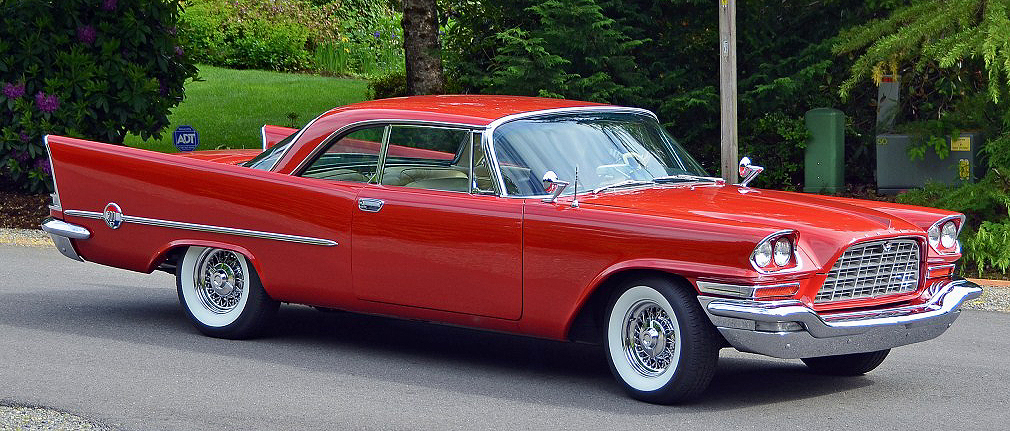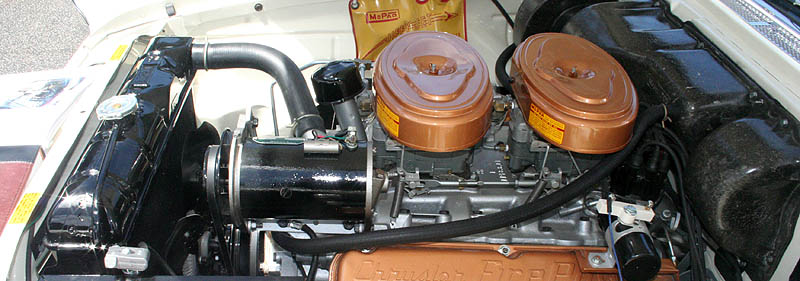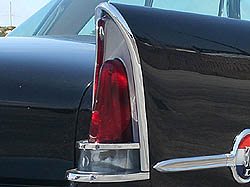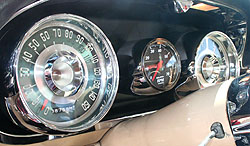
When looking to buy a 300D there are
certain things to look for. This is true of any 300, but for this
article, we’ll just look at the D. You’ve chosen a
remarkable 300D.
Matching the Numbers
Two sets of numbers will verify that
this is a 300D. The VIN plate is located on the driver’s door
hinge pillar. This tag is an aluminum rectangle with the serial
number stamped on it. The first 3 should read LC4 followed by 4
numbers underneath. The L stands for 1958, the C is for Chrysler, the
4 designates the 300D model. The following 4 numbers are the
sequential production numbers starting with 1001, the first 300D made
and ending with 1810, the last 300D made. The tag is tack welded to
the pillar. If it has been tampered with, attached with screws,
re-welded, the stamping changed or is missing, beware of this car
until you have more information about it. These tags can fall off or
have been removed during a restoration, but more research is
definitely called for.
The second set of numbers is the
Body Plate. This larger tag painted over at the factory to match the
body paint is located on the passenger side of the radiator yoke.
Across the top of this plate are the following letters:
MDL SCDL ITM PNT TRM
Directly under these will be found
letters or numbers.
MDL
is the model of the car. 592 is a 300D special club coupe, 595 is a
300D convertible.
SCDL
is the scheduled build date. For example, an early D built on October
22, 1957 will have a 1022 stamping. A late production D built on
April 1, 1958 will have 0401 stamped.
ITM
is a pretty useless number for us. It is the number of cars firmed
for production on that schedule date previously noted.
PNT
is the color the D was painted. In 1958, a set of three letters were
used, e.g., XXX means Ermine White. If the stamping says 999, then
that is a specially ordered color.
TRM
is interior code. Standard leather interior is 016. Special order
interior is 888.
The bewildering sea of letters and
numbers in the center of the tag show exactly which options the D
came with. In the lower left corner of the tag are the letters SRL.
Below this are 4 numbers. In 1958, these numbers are a repeat of the
car’s serial number. If these numbers do not match the VIN
plate, beware. Over the years and for obvious reasons, many 300’s
were involved in front end collisions. The repair shop would source a
new front end and many times did not replace the tag or they would
install a good used front end from a junkyard 300C, D, or E with the
wrong body plate information from that, a different 300.
If you are serious about purchasing
a 300D, check with the club’s Microfilm Research to verify the
authenticity of the car. You will have to make a pencil rubbing of
both plates to send to Gil Cunningham. The club’s Archive Files
is the place to find out the known history of a 300 letter car and is
also a very sound investment of time.
The Engine
We will not try to tell you how to check the
mechanical condition of the car. It should have the 392 engine with
two 4 bbl carburetors.
 The engine number stamped on top of the block
behind the thermostat housing should start as 58N3. The 3 indicates
300D. Other 392 hemis don’t have a 3. Again check for number
tampering. A factory short block 392 hemi will have a red tag
flimsily attached to the passenger’s side of the engine. 0133
may be stamped on it. This block will have no engine number stamped
on the top boss. It will be blank. An easy clue to check if it is a
high po engine is to see if the valve covers have the valve stem
clearance “bump” only found on high po hemi engines. The
valve covers should have Chrysler Firepower stamped on them. The
Carter WCFB carburetor numbers are on a too easily lost aluminum tag
attached to an airhorn body screw. Numbers should be 2741S front and
2742S rear. These carburetors are hard to locate. The 300D air
cleaners are also hard to locate items. They are oval and the same as
300E and 300H. Neither the valve covers nor the air cleaners should
be chromed; they are painted gold.
The engine number stamped on top of the block
behind the thermostat housing should start as 58N3. The 3 indicates
300D. Other 392 hemis don’t have a 3. Again check for number
tampering. A factory short block 392 hemi will have a red tag
flimsily attached to the passenger’s side of the engine. 0133
may be stamped on it. This block will have no engine number stamped
on the top boss. It will be blank. An easy clue to check if it is a
high po engine is to see if the valve covers have the valve stem
clearance “bump” only found on high po hemi engines. The
valve covers should have Chrysler Firepower stamped on them. The
Carter WCFB carburetor numbers are on a too easily lost aluminum tag
attached to an airhorn body screw. Numbers should be 2741S front and
2742S rear. These carburetors are hard to locate. The 300D air
cleaners are also hard to locate items. They are oval and the same as
300E and 300H. Neither the valve covers nor the air cleaners should
be chromed; they are painted gold.
The Body
The body of the car looks remarkably like a 300C
but there’s lots of differences. The windshield will always be
compound curved at the top which is only found on the 300C
convertible and 300E. There is no spoiler as with a 300C coupe.
 The
smaller red plastic with “silvered” housing area exterior
to the tail lights is an obvious giveaway to the car’s year –
but we’ve seen with the greater availability of the ’57
tail lights, sometimes ‘57s will be in use on ’58 300Ds
(these housing assemblies will fit perfectly.) The side medallions
contain the letter D. The wheel covers have the 300 medallion in the
center with a chromed pot metal spinner housing. A fairly common
option was stone shields in ’58. Look for stainless dress trim
forward of the external rear wheel house opening.
The
smaller red plastic with “silvered” housing area exterior
to the tail lights is an obvious giveaway to the car’s year –
but we’ve seen with the greater availability of the ’57
tail lights, sometimes ‘57s will be in use on ’58 300Ds
(these housing assemblies will fit perfectly.) The side medallions
contain the letter D. The wheel covers have the 300 medallion in the
center with a chromed pot metal spinner housing. A fairly common
option was stone shields in ’58. Look for stainless dress trim
forward of the external rear wheel house opening.
And there is the rust. Always take
your magnet to check for body filler. Common exterior body rust spots
are front fenders (over the headlights), hood nose, front fender
bottoms, rocker panels, rear quarter wheel openings. Check the frame
for rust. Inner body panels should also be checked. Pull up the trunk
carpet and check the trunk floor. Inside the car check the floor
especially where you put your feet front and rear. Also, check the
front seat track wells.
The Interior
The leather interior is
unique to the 300D. In fact, almost every item in the interior is s
300D only item. Check
the condition of the leather, rot and sun scald cannot be overcome.
 Gary Goers is a Legendary Interior dealer and offers very nice
interior parts. The dash instrument housings are chromed.
Check that
you have a 150 MPH speedometer. All other models with have a 120
speedometer. The headliner is usually a cloth one that did not hold
up well. Two holding strips will run from windshield to rear window.
If the headliner is not badly soiled, leave it alone! It is fragile
and often disintegrates when cleaned. So far there is no source to
replace this version of headliner. Any missing interior pieces will
also be hard to replace. Gary Goers is a Legendary Interior dealer and offers very nice
interior parts. The dash instrument housings are chromed.
Check that
you have a 150 MPH speedometer. All other models with have a 120
speedometer. The headliner is usually a cloth one that did not hold
up well. Two holding strips will run from windshield to rear window.
If the headliner is not badly soiled, leave it alone! It is fragile
and often disintegrates when cleaned. So far there is no source to
replace this version of headliner. Any missing interior pieces will
also be hard to replace.
The Test Drive
Start it up, see if it goes and most importantly
see if it stops. If you are not familiar with a 300, we urge you to
attend our twice annual meets. Take a look at the cars and ask to
drive one or more. If you decide you absolutely want a certain year
300, take lots of pictures. Ask the owner questions about the
particular weaknesses of that year and you will most likely learn
more than you ever thought possible. If you have found the car you
want but feel unsure as to its condition or authenticity of parts
(after checking the numbers), check your roster for a club member
near you owning that model 300 and ask if he will come with you to
see the car. Some trip expenses and a good lunch may save you a lot
of grief down the road. Most of us are very willing to help. Just
ask!
Other Numbers To Call
In your latest newsletter you will find the phone
numbers of the Club Technical Consultant, George Riehl and
consultants for each model year. Give them a call and they will all
be glad to help. That’s why they’re here. Happy Three
Hundreding!!
Back
|